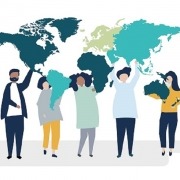The World Comes Together In Online Games
When we talk about increased globalization, we usually imagine a world where businesses are operating all over the world, a tasty Pad Thai can be ordered at an Irish pub in Toronto, Canada and people have more opportunity to interact with others from different parts of the world through increased travel.
One of the unexpected places that globalization occurred years ago, however, is in the world of online games. Thanks to the Massively Multiplayer Online Game, and popular titles like EverQuest and World of Warcraft, players from all over the world interact with each other, usually with a common goal of conquering a dungeon or defeating a particularly powerful enemy.
It’s interesting to see how online gaming manages to satisfy two different cultural needs. For those with a preference for interacting with those that have a common regional outlook, game makers have provided communities where Europeans and play together, where Japanese players can gather, and where North Americans can play. But these aren’t mandatory requirements, especially for those that want to play at odd hours, or with people they are unfamiliar with, so it’s not uncommon to see people from Brazil, the United States, Germany and Russia all playing together in the same group to achieve a common goal. Sometimes for these activities communication is required, and people will need a common language. Other times, no speech is required, as in-game communication tools like gestures or translators are provided, so even if a person can’t say “The treasure is here,” they can point to it, use a stock phrase provided by the game’s chat capabilities.
Online games as a meeting place
Then there are more unorthodox online worlds such as Second Life which isn’t even a game, so much as a space in which to socialize and experiment with creativity. In places like this, people from all over the world come together, dancing in virtual night clubs, shopping together and meeting and greeting in vast public digital spaces. Here we see people with no geographical boundaries meeting and learning about each other, and even learning something of the different languages that separate them. In the artificial noon day of Second Life, insomniac Egyptians can chat with alert Americans who are still enjoying an early evening in their part of the world, while Malaysians get up early in the morning to log in and join their friends.
This is just a hint of what’s coming in the future thanks to new technologies like virtual reality that are going to take online socializing to new levels. By immersing people in these game worlds, people will feel more connected to each other than ever before. The interaction and cooperation we see in online gaming worlds is only going to grow as virtual and online socializing take on even more importance. People will not just be able to communicate and interact in these digital spaces, they will learn, and even do business with each other. The online worlds of games are already giving us a brief glimpse of a digital lifestyle where people from all over the world can meet at the same time regardless of geography or time of day. The only limits will be the willingness to communicate and learn from one another.






















Leave a Reply
Want to join the discussion?Feel free to contribute!